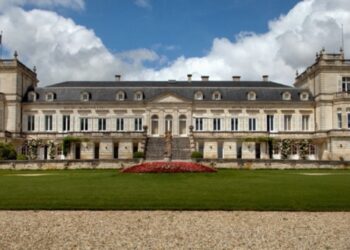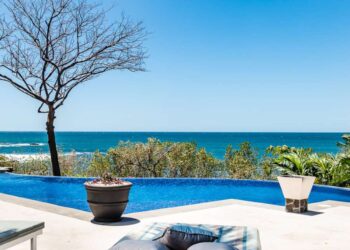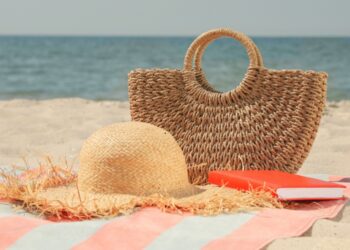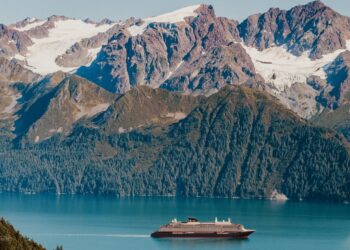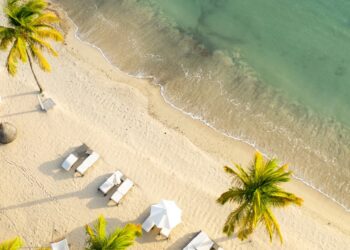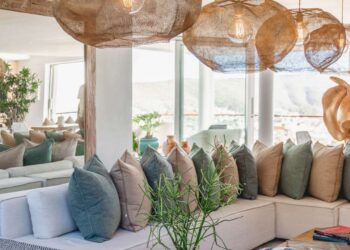The entrance is unexpected. Passing through a residential neighborhood in tony Rancho Mirage, California — past meticulously restored mid-century modern homes surrounded by flowering cacti — my driver slows to a stop. “You will need to show ID,” he says as, in perfect symmetry, the back car window rolls down; a guard collects and scrutinizes my credentials, then ushers us through.
Set on 230 acres, the property behind the mysterious electric gate, Sensei Porcupine Creek, served as billionaire Larry Ellison’s private estate until late 2022 when the Oracle co-founder transformed it into a Japanese-inspired retreat for serious wellness enthusiasts. The concept is modeled after Ellison’s original Sensei Lanai, a Four Seasons Resort, which he co-founded with David Agus, M.D., a prominent physician and leading biomedical researcher. But unlike Hawaii, this Coachella Valley version offers an exclusive, stand-alone wellness experience — that is also insanely luxurious.

Driving slowly toward the Estate House, my driver calls out the large-scale casting of pop-artist Robert Indiana’s “One Through Zero (The Ten Numbers),” part of Ellison’s personal art collection. The enormous, brightly colored aluminum sculptures are said to represent the decades of our lives: our 20s, 40s, 60s, 90s, before abruptly reverting back to zero. The installation (which I revisit on foot during my stay) takes us from birth to passing, offering pause and reflection on how we want to live each chapter of our lives. Other colorful sculpture works are also on display: Keith Haring’s “Green Dancing Man” (representing joy) and Yoshitomo Nara’s white “Your Dog” (embodying the spirit of a child’s playmate and reminding how the world looks through the eyes of a child).
Accommodations (just 22 rooms and villas) as well as spa treatments are equally complex and transformative — seemingly minimalistic and elegant on the surface, but deeply rooted in (Japanese) tradition and (western) science.
The Rooms

“Wow.”
It’s not a word I use lightly (or often) but taking in the natural light, gorgeous live orchids, Japanese art, and minimalist teak furniture, no better description comes to mind. I am entranced. Oversized doors spill onto a terrace so large I ask my (personal) butler, who is graciously settling me into the room, if it is a shared space. “No, it is all yours,” she smiles, as I move from end to end, delighting in the teak sun loungers, cushy chairs, and trickling waterfall pool below me. As the butler discreetly disappears, I change into the waiting taupe-linen yukata (traditional Japanese robe) and matching slippers; then pour myself a cup of tea from a small white ceramic pot, and ceremoniously serve it to myself on the terrace.

It is only later that I discover the beauty and wonder of my ensuite bath. A deep-soaking Japanese Toto tub flirts in greeting next to an oversized walk-in shower, well-lit double vanity, and, tucked into its own closed-door room, a heated Toto toilet. Just as my hand reaches for the bath salts and tub faucets beckoning to be turned, I remember: a customized itinerary has been mindfully crafted for me. And soon to start: a sound journey — Tibetan singing bowls, ocean drum (that sounds like waves), and gong — with Per (pronounced Pear). I find him waiting for me, feet bare, just beyond the flower-dense path of calla lilies, bougainvillea, birds of paradise, and sweet plumeria (a nod to Hawaii), in the yoga room.
The Concept: Move, Nurture, Rest

Weeks before my scheduled arrival, a member of the Sensei team reached out to me with questions about my lifestyle, daily exercise regimen, dietary preferences, and intentions for my stay. From that in-depth conversation, a customized wellness plan was shaped. No two guest itineraries are ever exactly the same (even for couples traveling together). Yet all reflect Sensei’s overall concept and mantra: “Move (how we interact with the world); nourish (what fuels us); and rest (how we recover and grow, i.e. mindfulness and meditation to wind down). For all resort guests (and never open to the public), the cuisine — even the room service menu — is by Nobu (created by legendary Japanese Chef Nobuyuki “Nobu” Matsuhisa). All of the Nobu classics from black cod miso and rock shrimp tempura are there, as is the omakase multi-course tasting menu.
Fitness, spa treatments, and resort activities vary according to individuals’ customized plans. For some, days may focus on hiking; since the resort’s opening, hikes have been on the estate, but starting 2025, guided hikes to nearby areas (like Joshua Tree National Park and Indian Canyons) are being offered. Others seeking solace in the desert may concentrate on workouts (intense and light), and scientific approaches like thermal body mapping designed to reveal points of tension and inflammation in the body. Some come for golf. The course (previously private), set at the foot of the Santa Rosa Mountains, is framed by waterfalls, Madagascar palms (skinny, crooked, twisty palms beloved by hummingbirds) and cacti; the 15th hole, said to be exhilarating. Others, like myself, come simply to reset — mind, body, and soul.
Highly Customized Treatments

While not blatantly apparent, my Sensei plan focuses heavily on mindfulness and spiritual growth: one-on-one yoga and meditation, serene property (and art-filled) walks, and a sensory eating experience with resident nutritionist, Brooke. During our private, alfresco lunch — hummingbirds flitting next to us — she encourages me to slowly feel, smell, taste, the textures of my beautifully prepared Nobu bento box: an artistic arrangement of eggplant, salad, sea bass, rice, and a rainbow of vegetables.
“So often, we eat on the run, or skip meals completely, which only revs up our nervous system,” says Brooke, pausing to hold the warm cup of soba tea in her hands, before picking out one single, teeny crisp from her salad, loaded with flavor. “We want to calm the nervous system, to feel safe,” she continues. “Everything we do [at Sensei] is about slowing down, being mindful, and nourishing.”
At this, she encourages me to switch my chopsticks to my non-dominant hand (left) as I continue working through my meal — the gentle lifting and hugging-like motion of the chopsticks (versus the cutting and jabbing of a knife and fork) work to slow down the eating process even more. Although it is harder than it sounds.
Spa treatments are also highly personalized, and in ways not necessarily obvious. It is not until watching my therapist, Christine, don a full-body work apron that I realize how long it has been since I have had had a proper facial (a detail gleaned during my intake assessment). While I am often found in the spa — being scrubbed, wrapped, bathed, steamed, pummeled, soaked, and massaged — my face is often an afterthought or forgotten all together. But not in Christine’s capable hands.

Her 90-minute Gua Sha Uplifting Facial features Seed to Skin, a clean product line from Tuscany that is stored in jars with stainless steel lids, and so pure it has a shelf life of only six months. A jade, silver, or rose (in my case, jade) gua sha — a smooth-edged tool used for centuries in Asia — works alongside Christine’s deft hands to masterfully stroke and lift the skin, stimulating lymphatic drainage and unblocking stagnant energy. Startling-cold cryotherapy globes complete the treatment, working to reduce puffiness and increase cell circulation.
The result: a dewy masterpiece so transformative that, hours later, when I take my seat at the Nobu sushi bar, the woman next to me insists I am from LA. (I live in New Jersey).
“Your California glow,” she smiles. “It gives you away.”
Feature image by Noah Webb, courtesy of Sensei Porcupine Creek.


